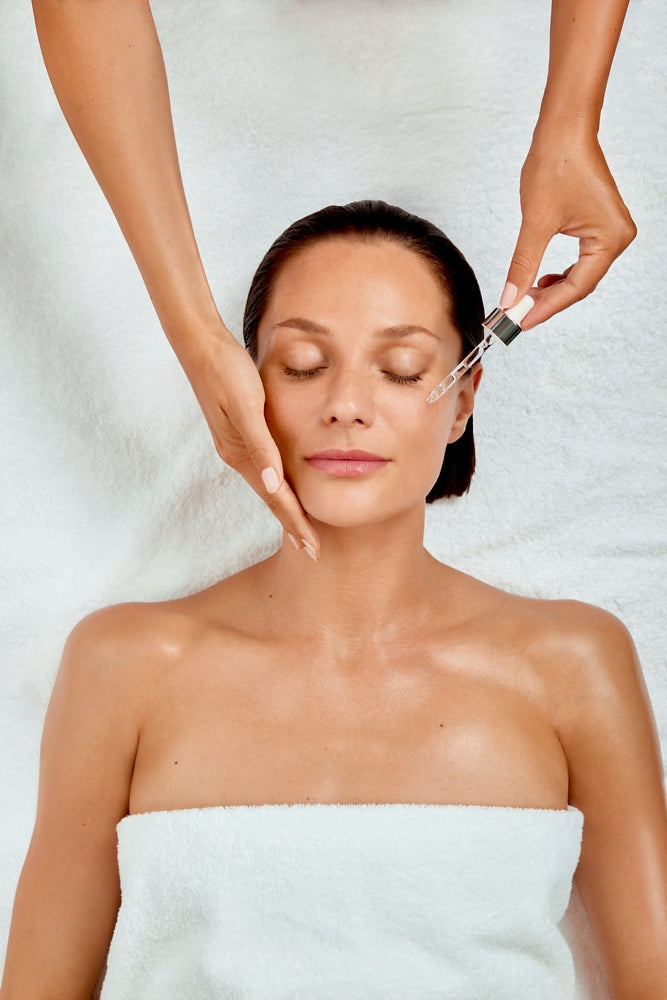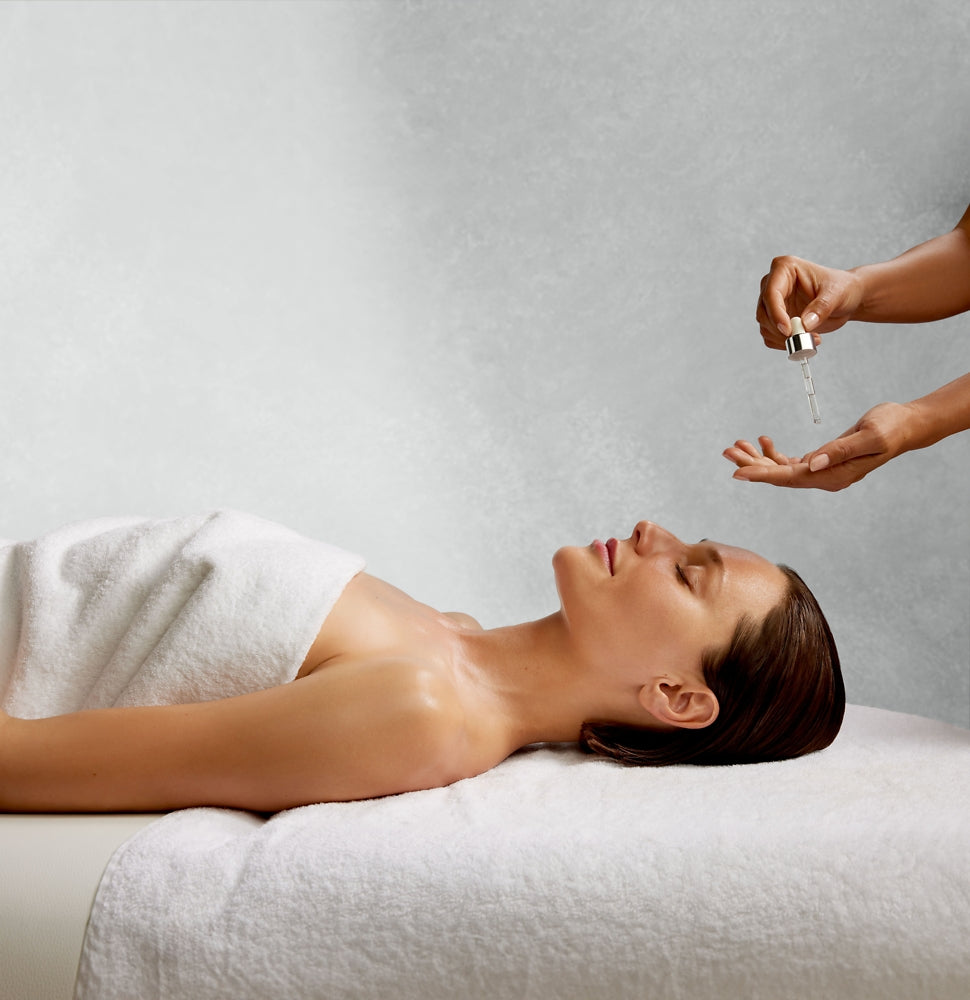
AHA PEELS
AHA Peels are a type of chemical peel using naturally derived alpha-hydroxy acids (AHA) as their main components, such as lactic, tartaric, citric, malic and glycolic acids.
Applied to the skin, these fruit acids dissolve the filler substance between the cells of the epidermis which loosens the skin structure. Depending on the peeling and application intensity, the cells of the epidermis can be removed at varied depths.
This has your skin feeling instantly fresh, radiant and smooth. Two to three weeks post your skin will feel more youthful, radiant, fewer lines and wrinkles and a more regular, refined skin structure.

Bespoke Facials
Discover the epitome of personalized skincare with our bespoke facials, meticulously tailored to meet the unique needs of every individual, regardless of skin type. Gone are the days of one-size-fits-all treatments; our approach blends the sophistication of traditional spa rituals with modern, targeted solutions. Indulge in a luxurious experience where every element is customized to enhance your skin’s natural radiance, ensuring a transformative and truly rejuvenating facial each time you visit.
FAQ's
Chemical Peels FAQ
1. What is a chemical peel?
A chemical peel is a cosmetic treatment that uses a chemical solution to exfoliate and remove the outer layers of the skin. This process can help improve skin texture, reduce fine lines, and address issues like acne scars and uneven pigmentation.
2. How do chemical peels work?
Chemical peels work by applying a solution to the skin that causes controlled damage to the outer layer. This stimulates the skin's natural healing processes, leading to the growth of new, healthier skin.
3. What types of chemical peels are available?
There are three main types of chemical peels:
- Superficial peels: Target the outer layer of skin for mild exfoliation.
- Medium peels: Penetrate deeper into the skin to address more significant concerns.
- Deep peels: Reach the deeper layers of skin for more dramatic results, often requiring more downtime. (CURRENTLY NOT AVAILABLE AT MS)
4. Who is a good candidate for a chemical peel?
Most people can benefit from chemical peels, but those with specific skin concerns like sun damage, acne, or uneven texture are often ideal candidates. A consultation with a skin professional will help determine if a peel is suitable for you.
5. What should I expect during the treatment?
During the treatment, a chemical solution will be applied to your skin. You may experience a slight tingling or burning sensation, which typically subsides quickly. The procedure usually takes 30 minutes to an hour, depending on the type of peel.
6. What is the recovery time?
Recovery time varies depending on the type of peel. Superficial peels may have little to no downtime, while medium and deep peels may require a few days to a week for the skin to fully heal.
7. How many treatments will I need?
The number of treatments needed varies based on individual skin concerns and goals. Many clients benefit from a series of peels spaced several weeks apart for optimal results.
8. Are there any side effects?
Side effects can include redness, peeling, and sensitivity in the treated area. These are usually temporary and resolve within a few days. Your skin professional will provide guidance on post-treatment care.
9. How should I care for my skin after a chemical peel?
After a chemical peel, it's essential to keep your skin hydrated and protected. Avoid sun exposure, use gentle skincare products, and follow any specific aftercare instructions provided by your skin therapist.
10. How can I prepare for a chemical peel?
To prepare for a chemical peel, avoid sun exposure, certain medications, and harsh skincare products for a few days prior to your treatment. A consultation with your skin therapist will provide personalised recommendations.
The following grades are available, should your skin be suited to one of these intensities:
Grade 1:
10% AHA Peel. Fruit acid chemical peel with low intensity. Suitable for all skin types. This peel contains 10% Fruit acids;
- Lactic acid - Tartaric acid - Citric acid
- Ensure a pleasant feeling on the skin
Grade 2:
20% AHA Peel. Moderate redness and discomfort. Visible skin response that can last post completion of treatment.
This Peel contains 20% Fruit acids;
- Glycolic acid - Lactic acid - Tartaric acid - Citric & salicylic acid
- Ensure a pleasant feeling on the skin
Grade 3:
30% AHA Peel. Fruit acid chemical peel with highest intensity. Mild to sever redness that quickly subsides. Minimal to no discomfort. A visible skin response that will subside before the end of the treatment. This Peel contains 30% Fruit acids;
- Glycolic acid - Lactic acid - Tartaric acid - Citric & salicylic acid
Book a skin consultation today, and our expert skin therapists will design a bespoke program tailored to your specific skin concerns. We will also provide you with personalised home care recommendations to prepare your skin for the appropriate peel treatment.
- Pregnant or Nursing Individuals: Hormonal changes can affect skin sensitivity and healing, making chemical peels risky.
- Individuals with Active Skin Infections: Conditions such as herpes simplex (cold sores) or bacterial/fungal infections should be treated before considering a peel.
- Those with Severe Acne or Rosacea: Active inflammatory acne or severe rosacea may worsen after a peel, so treatment should be stabilized first.
- Individuals with Certain Skin Conditions: Conditions like eczema, psoriasis, or dermatitis can be exacerbated by chemical peels.
- People with a History of Keloid Scarring: Those prone to keloids may experience adverse reactions from a chemical peel.
- Users of Certain Medications: Some medications, like isotretinoin (Accutane), can increase skin sensitivity and may require a waiting period before a peel.
- Allergic Reactions: Individuals with known allergies to the ingredients used in chemical peels should avoid them.
- Dark Skin Tones: Certain types of peels may pose a higher risk of pigmentation issues for individuals with darker skin. Consultation with a skilled professional is essential.
It’s important for anyone considering a chemical peel to have a thorough consultation with one of our a qualified skin therapist to assess their individual situation and skin type.
Chemical peels can cause varying degrees of discomfort depending on the type of peel being performed:
- Superficial Peels: These typically cause minimal discomfort, often described as a slight tingling or warming sensation. Most people find this level of discomfort manageable.
- Medium Peels: These may cause more noticeable sensations, such as a stronger burning or stinging feeling. This discomfort usually subsides quickly after the treatment is completed.
- Deep Peels: These can be more intense and may require a local anesthetic to manage pain. Clients often experience significant discomfort during the procedure, along with a longer recovery period.
(DEEP PEELS CURRENTLY NOT AVAILABLE AT MS)
Overall, while some discomfort is expected, most clients tolerate the procedure well, and the results often outweigh the temporary sensations experienced during treatment. Always discuss any concerns with your skincare professional prior to the procedure.
Pre-Treatment Care for Chemical Peels. To ensure the best results and minimize potential side effects, please follow these pre-treatment guidelines before your chemical peel appointment:
1. Avoid Sun Exposure: Refrain from sunbathing or using tanning beds for at least 1 week before your treatment. Sunburned or tanned skin is more sensitive and can increase the risk of complications.
2. Discontinue Certain Skincare Products: Stop using retinoids, exfoliants, alpha hydroxy acids (AHAs), beta hydroxy acids (BHAs), and any other active skincare products at least 5-7 days before your peel to avoid over-exfoliation.
3. Avoid Waxing, Electrolysis, or Depilatory Creams: Do not use hair removal methods on the area to be treated for at least 1 week before your chemical peel, as these can irritate the skin.
4. No Facial Treatments: Avoid facials, microdermabrasion, or any other skin treatments for at least 1-2 weeks before your chemical peel to prevent excessive irritation.
5. Stay Hydrated: Drink plenty of water in the days leading up to your appointment. Hydrated skin responds better to the peeling process.
6. Consult About Medications: Inform your practitioner of any medications you are taking, especially if they may increase skin sensitivity or affect healing.
7. Avoid Blood Thinners: If possible, avoid aspirin, ibuprofen, or other non-steroidal anti-inflammatory drugs (NSAIDs) for at least 48 hours before your session to reduce the risk of bruising.
8. No Makeup on the Day of Treatment: Arrive with a clean face, free of makeup, lotions, or other skincare products. This ensures that your skin is prepared for the peel.
9. Discuss Health Conditions: Notify your practitioner of any health conditions, such as a history of cold sores, as you may need antiviral medication before the procedure.
10. Plan for Downtime: Some peels require a few days of recovery, during which your skin may peel, flake, or be sensitive. Plan your treatment accordingly.
Following these pre-treatment guidelines will help prepare your skin for a successful chemical peel. If you have any questions or concerns before your appointment, please feel free to reach out to us.
Post-Treatment Care for Chemical PeelsProper aftercare is essential to ensure the best results and to help your skin heal effectively after a chemical peel. Please follow these guidelines:
1. Avoid Sun Exposure: Protect your skin from direct sunlight for at least 1 week. Always use a broad-spectrum sunscreen with SPF 30+ when going outside, even on cloudy days.
2. Keep Your Skin Hydrated: Use a gentle, hydrating moisturizer regularly to keep your skin soft and to support the healing process. Avoid products with active ingredients (like retinoids or acids) for at least 1 week.
3. No Exfoliation: Refrain from using exfoliating products, scrubs, or tools for at least 1 week. Let the peeling process occur naturally without interference.
4. Avoid Picking or Peeling: Do not pick, peel, or scratch at your skin as it heals. This can lead to scarring, infection, or pigmentation issues.
5. Gentle Cleansing: Wash your face with a mild, non-abrasive cleanser and lukewarm water. Pat your skin dry gently with a soft towel.
6. Avoid Heat and Sweating: Stay away from saunas, hot showers, and strenuous exercise for at least 48 hours to prevent irritation and prolong redness.
7. No Makeup for 24-48 Hours: Avoid applying makeup or other skincare products for the first 24-48 hours post-treatment to allow your skin to recover.
8. Stay Hydrated: Drink plenty of water to help your skin heal from the inside out and to maintain overall hydration.
9. Expect Redness and Peeling: Redness, dryness, and peeling are normal after a chemical peel and should subside within a few days. The peeling process may vary depending on the strength of the peel.
10. Avoid Other Facial Treatments: Do not schedule any other facial treatments (e.g., waxing, laser treatments) for at least 2 weeks post-peel to avoid stressing your skin further.
11. Sleep on a Clean Pillowcase: Use a fresh, clean pillowcase to avoid introducing bacteria to your treated skin while you sleep.
12. Consult Your Practitioner: If you experience any prolonged or severe discomfort, or if you have any concerns about your recovery, please contact us immediately.
By following these post-treatment care instructions, you’ll help your skin heal effectively and achieve the best possible results from your chemical peel. If you have any questions or concerns during your recovery, please don’t hesitate to reach out to us.
BiorePeel FAQ
BioRePeel is a dual-phase chemical peel that combines exfoliating and rejuvenating properties. It is designed to improve skin texture, reduce fine lines, and enhance overall radiance without significant downtime.
2. How does BioRePeel work?
BioRePeel uses a unique formulation that penetrates the skin to promote cell turnover while simultaneously providing hydration and nourishment. It helps to exfoliate dead skin cells, stimulate collagen production, and improve skin elasticity.
3. Who is a good candidate for BioRePeel?
BioRePeel is suitable for various skin types and concerns, including dullness, uneven texture, acne scars, and signs of aging. A consultation will help determine if it’s the right choice for you.
4. What should I expect during the treatment?
During a BioRePeel treatment, a solution is applied to your skin, which may cause a slight tingling sensation. The procedure typically lasts around 30 minutes, and no extensive downtime is required.
5. Are there any side effects?
Most clients experience minimal side effects, such as mild redness or sensitivity, which usually resolve quickly. Your skin therapist will provide guidance on managing any reactions.
6. How many treatments will I need?
The number of treatments depends on your specific skin goals. Many clients see optimal results with a series of 3-6 sessions spaced a few weeks apart.
7. How should I care for my skin after BioRePeel?
Post-treatment care includes avoiding sun exposure, using gentle skincare products, and keeping your skin well-hydrated. Your therapist will provide tailored aftercare instructions.
8. How soon will I see results?
Results can often be seen immediately after treatment, with continued improvement over the following weeks as skin cell turnover increases.
9. Can BioRePeel be combined with other treatments?
Yes, BioRePeel can be effectively combined with other treatments, such as facials or microneedling, to enhance overall results. Your therapist can help create a comprehensive skincare plan.
10. Is there any downtime with BioRePeel?
One of the key benefits of BioRePeel is that it requires minimal downtime. Most clients can return to their normal activities immediately after treatment.
Here are some individuals who may not be suitable candidates for BioRePeel:
- Pregnant or Nursing Individuals: Hormonal changes can affect skin sensitivity and healing.
- Those with Active Skin Infections: Conditions such as herpes simplex or other infections should be resolved before treatment.
- Individuals with Severe Acne or Rosacea: Active inflammatory skin conditions may worsen after treatment.
- People with Certain Skin Conditions: Conditions like eczema, psoriasis, or dermatitis can be aggravated by peels.
- Individuals with Allergies: Those with known allergies to any ingredients in the BioRePeel formulation should avoid it.
- Recent Chemical Peels or Laser Treatments: Those who have undergone these procedures should wait a specified period before having a BioRePeel.
- Keloid Scarring History: Individuals prone to keloid scars may experience adverse reactions.
- Sensitive Skin: Those with highly sensitive skin may need to consult a professional to assess suitability.
A thorough consultation with a qualified skincare professional is essential to determine if BioRePeel is appropriate for individual skin needs.
BioRePeel typically causes minimal discomfort. Most clients describe the sensation as a mild tingling or slight warmth during the treatment. Because it is designed to be a gentle procedure, most people find it quite tolerable. After the treatment, some individuals may experience mild redness or sensitivity, but this typically resolves quickly. If you have specific concerns about pain or sensitivity, it’s best to discuss them with your therapist during the consultation.
Pre-Treatment Care: Client needs to avoid the following prior to treatment.
-5 Days prior avoid any active skincare: Vitamin A, topical prescriptions, exfoliants and certain Vitamin C serums.
-14 days prior no injectables.-7 days prior no laser hair removal/ waxing in areas of treatment.
-14 days prior no tanning/ unprotected sun exposure.
Post Treatment Care: Following post treatment care will help to minimise potential side effects and downtime.
-Keeping skin hydrated is mandatory if you wish to achieve radiant skin.
-Avoid direct sun in treated areas. SPF 30/50+ is mandatory daily.
-Avoid all hair removal treatments 14 days post treatment.
-Avoid heat inducing activities for 24hrs.
-Avoid picking or scratching your skin.-Avoid active skincare for 5-7 days post treatment.
